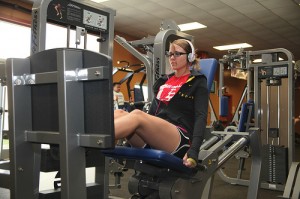By Michelle Sutton-Kerchner
Breathing comes naturally. Breathing well sometimes can be a challenge. Exercise to breathe better. A regular fitness routine can help prevent lung conditions, including cancer …
Breathing well is a simple pleasure we take for granted. Ask anyone whose breathing has been compromised by asthma, pneumonia, COPD, emphysema, or worse. The ability to breathe freely and deeply reverberates throughout our entire well-being, physical and mental. A good breath releases stress; several can reduce tension. A simple sigh can expel a day’s worth of emotions. Shallow breathing from stress or bronchial inflammation is suppressing and uncomfortable.
Improve Respiratory Health
Cardio fitness is one of the best methods to exercise your lungs. The activity cleans and strengthens the lungs, just as it does for the rest of your body. A hearty aerobic workout builds healthy lungs. Lung function improves as does overall physical functioning. When muscles are doing their share of work, we don’t become breathless as easily. Lungs can focus on their job without carrying the weight (literal and figurative) of other parts of the body.

Yoga, martial arts, Pilates, T’ai Chi, and other fitness methods that focus on breathing techniques directly improve the lungs through deliberate breathing and balance control. The famous “deep cleansing breath” is just that. Clean, well-exercised lungs efficiently oxygenate the entire body.
Those suffering compromised breathing from conditions like COPD or allergic asthma require more energy to breathe. Exercise helps the body use oxygen more efficiently. Aerobic activity improves endurance by strengthening respiratory muscles. Complement your workout with a weightlifting program that focuses on the upper body. This increases the strength of breathing muscles. A consistent, multifaceted fitness program can improve breathing on a regular basis.

Studies show exercise benefits the lungs of smokers and nonsmokers alike. Strengthening your lung capacity can help delay the onset or severity of illnesses common among smokers, such as COPD, emphysema, and asthma. A heart-revving workout can counteract some of the damage caused by cigarette smoking. This helps assure your best health– while you attempt to quit, of course.
Remember always to have rescue medicine quickly available when working out. If shortness of breath becomes a burden beyond what is natural for an upbeat workout, slow it down or take a rest. Warm-ups and cool-downs are especially important for those with lung issues.
Exercise to Help Prevent Lung Cancer
 A mention of cigarette smoking would be remiss without a follow-up on lung cancer. Although you can have one without the other, the link between the two is dangerously strong. Regardless of the cause, lung cancer kills more people in the United States than any other cancer. The numbers who fall victim every year are in the hundreds of thousands.
A mention of cigarette smoking would be remiss without a follow-up on lung cancer. Although you can have one without the other, the link between the two is dangerously strong. Regardless of the cause, lung cancer kills more people in the United States than any other cancer. The numbers who fall victim every year are in the hundreds of thousands.
A study presented at an American Association for Cancer Research conference showed physical activity helps prevent lung cancer. For those already diagnosed, appropriate exercise during treatment was shown to improve quality-of-life and increase survival rate.
The decreased risk for lung cancer through exercise did not discriminate. Benefits were gained by both genders, smokers, nonsmokers, and former smokers. A study reported in the journal Cancer Epidemiology, Biomarkers & Prevention showed female smokers could reduce their risk of developing lung cancer by 65 percent through moderate activity. This number increased to 72 percent in those women with high physical activity levels.
As seems the trend with exercises’ many other positive benefits, you don’t need to be a triathlete to realize the perks. Tasks like yard work were included in the study and associated with reduced lung-cancer risk. A regular fitness routine also reduced the incidence of death from lung cancer, especially in women.
Exercising to Survive Lung Cancer
The American College of Sports Medicine strongly recommends cancer patients get active. Experts advise exercise during and after cancer treatment. A personal trainer or Group Fitness instructor, along with a physician’s guidance, assures each patient proceeds at his/her comfort level.
The fear of battling cancer, and managing a life in remission, is often overwhelming. Inviting exercise into your life at this time, even if you were previously a couch potato, can be a blessing. More than ever, do something healthy for yourself. The exercise habit takes you beyond this life-altering challenge and creates its own lasting healing power. It can be a gift you give yourself that travels with you beyond this difficult journey.

For some, exercise is an element of comforting normalcy– an opportunity to see workout buddies, groove away an hour at fitness class, chat with friends at the Center’s Front Desk. It prevents illness (or an injury)– cancer or otherwise– from defining us. It provides an escape, to alleviate worries and go beyond traditional medicine. It’s also something enjoyable amidst the turmoil of illness.
Attitude affects the body’s ability to heal. A safe, invigorating workout encourages a positive outlook and improves self-confidence. At a time like this, it’s essential to believe in yourself and your body’s capabilities. Exercise accomplishments can reflect your outer and inner strength.
Consider Gentle Yoga classes. Yoga is being investigated for its ability to increase natural “killer cells,” a type of white blood cell that feasts on cancer cells. Combined with its cleansing breaths and other breathing techniques, lungs on yoga receive double the love.
As with the general population, cancer patients and survivors should strive for 150 cumulative minutes of moderate exercise weekly. The National Cancer Institute advices any increases in intensity be leveled out with decreases in duration. This helps avoid overexertion. If possible, incorporate fitness into your daily regimen, just as you would schedule medicine, chemotherapy, and doctor appointments.
Treatments, and the disease itself, result in fatigue being a major complaint among sufferers. The core-deep exhaustion experienced by those with cancer can be lessened with physical activity. Exercise can be a safe complement to cancer treatment programs. It is proven to improve mood, relieve anxiety and depression, and combat fatigue.
Many illnesses and cancers still do not have a cure. Yet, we can be proactive in living a healthy life, filled with invigorating exercise, good nutrition, and the power of determination. Decide to be a fighter against life’s illnesses and threats. Live like a winner, one breath at a time.
Sources
www.cdc.gov
“Can Exercise Prevent Lung Cancer and Improve Survival?” by Lynne Eldridge at www.about.com.
“COPD and Exercise: Breathing and Exercise Programs for COPD,” at www.webmd.com.
“Exercise and Lung Cancer,” by Dana George at www.livestrong.com.
“Exercises Effects on the Lungs,” at www.nytimes.com.
Image Credits
Breathe (introductory photo): http://www.flickr.com/photos/34053291@N05/3431738333/
Yoga: http://www.flickr.com/photos/lululemonathletica/3681654917/
Cycling: http://www.flickr.com/photos/jenumfamily/5365523384/
Anti-cancer: http://www.flickr.com/photos/medusajewellery/6644297073/
Workout equipment: http://www.flickr.com/photos/mcas_cherry_point/6714749721/
 Fitness & Wellness News Your Source for Fitness News, Wellness News, Health News, and Nutrition News!
Fitness & Wellness News Your Source for Fitness News, Wellness News, Health News, and Nutrition News!




